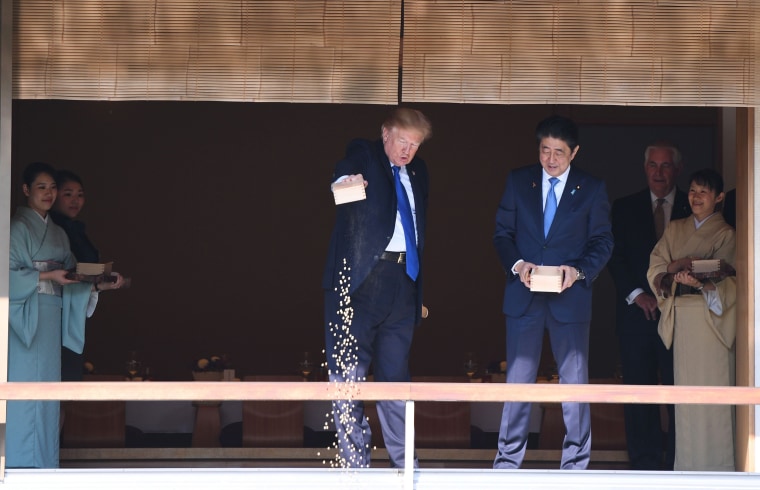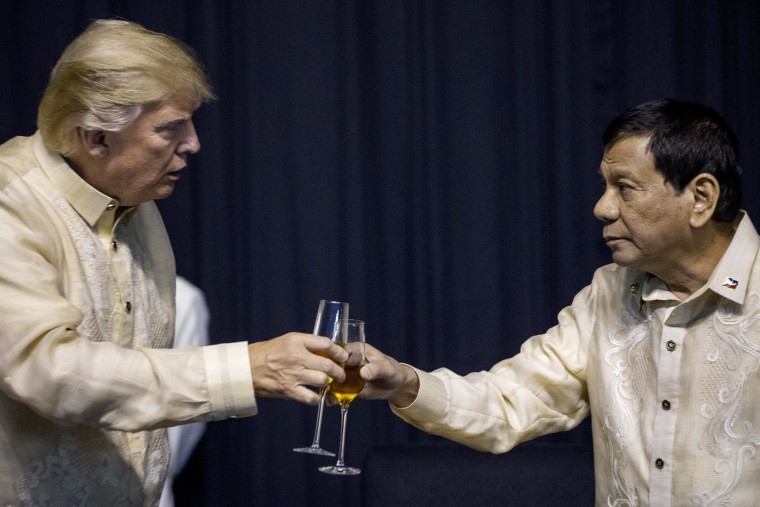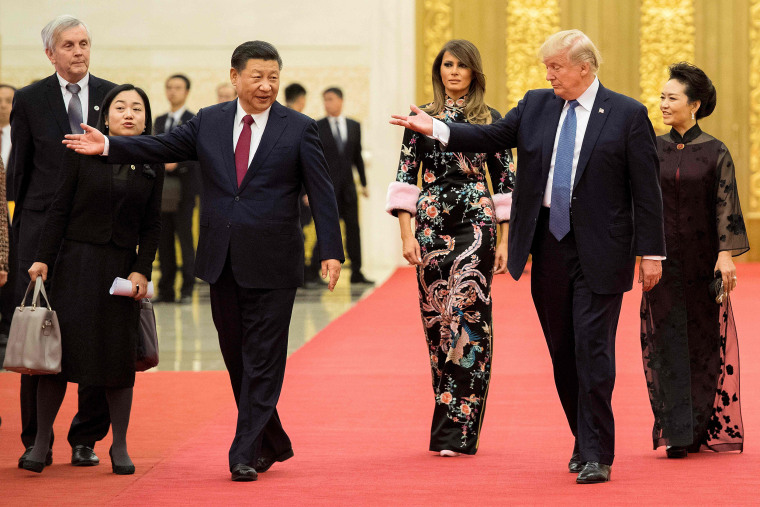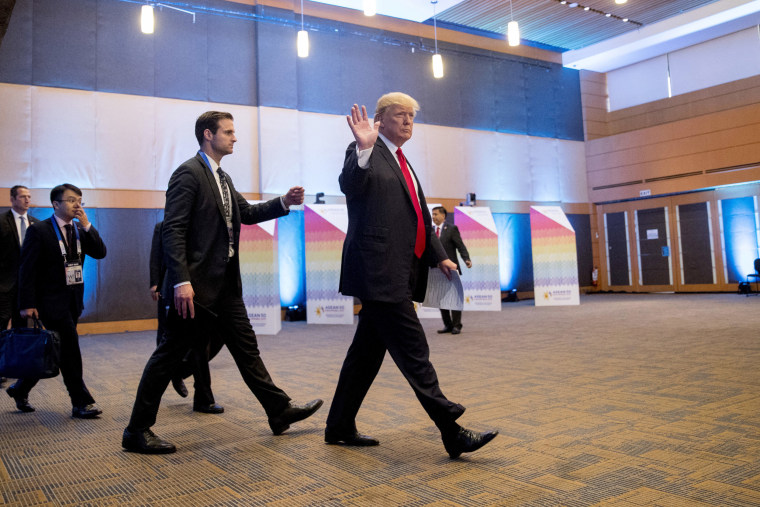MANILA, Philippines — One koi pond, five countries, 11 days and 66 tweets later, President Donald Trump's trip to Asia — the longest of any U.S. president since George H.W. Bush — is over.
After extending his travels by a day to attend more of the East Asia Summit here, Trump finally headed home Tuesday after recapping his trip for reporters, however beleaguered from the travel they might be.
"Would you like to stop in another couple of countries?" he joked with the press. "'Cause we can do that if you want."
It was all well worth it, Trump said, promising with his characteristic understatement: "The fruits of our labor are going to be incredible."
Here are the top takeaways:
1. Trump stayed on message, mostly
Though there was a steady stream of news, the usual Trump fire hose was — comparatively speaking — a modulated trickle.
The president repeatedly pounded his talking points on the need for "responsible nations" to unite against the North Korea nuclear threat and for "free and fair" trade that would benefit not just the U.S., but any country that chose to partner with and invest in America.
Nothing is perfect, of course. Trump did find himself off message briefly on the leg between Vietnam and the Philippines when he tried to clarify whether he believed Russian President Vladimir Putin's denials that the Kremlin interfered in the 2016 election.
And the language Trump used overseas was, well, not always diplomatic. It's not every day you hear a president taunt the leader of North Korea as "short and fat."

2. Did someone say human rights?
The White House says human rights came up "briefly" during Trump's meeting with Philippines President Rodrigo Duterte. It was an issue many were wondering about even before the president sat down with the strongman, who has been widely condemned for abuses, particularly those perpetrated in the name of his war on drugs.
National Security Advisor H.R. McMaster previewed before the trip that any kind of big Trump speech or moment to draw attention to human rights concerns was unlikely as he wondered how much it helps to "yell about these problems" as opposed to discussing them behind closed doors.

But previous administrations have taken a more active and public role in calling out abuses on the world stage, setting moral precedents for the global community, while Trump has adopted a different approach while acting chummy with leaders like Duterte in the name of progress on other fronts.
It's not the first time, either. Trump has welcomed Egypt's President Abdel-Fattah el-Sissi and Turkish President Tayyip Erdogan to the White House — both leaders have been criticized by human rights organizations for a variety of abuses. And Trump didn't make an issue of it during their visits to Washington.
3. Hope on China
China was pressed during Trump's trip to "do more" when it comes to curbing aggression out of Pyongyang — and the president's sometimes over-the-top reactions to Kim were intended to push China to act more quickly in helping to further isolate the North Korean regime.
Reluctance from China to do something has frustrated past administrations, but President Xi Jinping's willingness to implement UN Security Council sanctions and take steps to stop Chinese banks from doing business with Kim has buoyed the Trump administration's hopes.

Aides said Trump had frank discussions with Xi, who agreed during his remarks to reporters that denuclearization of the Korean Peninsula was desirable and advocated an approach of "dialogue and negotiation."
4. Still dodging
Trump was pressed on events from the home front throughout his travels, notably gun control in the wake of yet another mass shooting and allegations that Republican Senate hopeful Roy Moore made sexual advances towards teenagers. The president used foreign soil as an excuse to stay on his foreign policy messaging points and to avoid making domestic news.
Not that the strategy always worked.
In response to a question from NBC News about whether he would employ "extreme vetting" of those seeking to buy firearms aftermath of a mass shooting in a Texas church, Trump chided this reporter for "bringing up a situation that probably shouldn’t be discussed too much right now." Vetting or gun control would have made "no difference" in Texas, the president said in an exchange that went viral.
The president also dodged when asked about Moore.
"I've been with you folks, so I haven't gotten to see too much," Trump told reporters on Air Force One when asked about the Alabama Senate hopeful, shifting the conversation instead to his TV habits. "I'm dealing with the president of China, the president of Russia, I'm dealing with the folks over here. So I haven't devoted — I haven't been able to devote very much time to it."
5. What is there to show for it all?
The president departed Asia promising a "major" announcement back in D.C. Whether that's a previously undisclosed win from his five-nation tour is unclear.
But what was clear to trading partners is that the rules, as they pertain to trade relationships with the U.S., had changed.
"The United States has to be treated fairly in a reciprocal fashion," Trump declared in a Wednesday tweet while at the East Asia Summit here. "The massive TRADE deficits must go down quickly!"
And certainly Trump brought that message loud and clear to Asian partners while advisers parroted the "free, fair, and reciprocal" trade talking point to reporters repeatedly throughout the trip.
The question now is what does the president have to show for his time spent in the region?
The White House touted over $250 billion in commercial trade deals signed while in China, but those are more business deals than trade agreements.
There is "lots of work left to do" in bringing the trade relationship to the point where Trump will be satisfied, Secretary of State Rex Tillerson told reporters.
On North Korea, though the administration seems to have gotten more from China than its predecessors, there's still a long way to go.
Tillerson said leaders in Beijing had advocated for more waiting — to measure the impact of existing sanctions on North Korea.
"It is creating some stress with North Korea's economy," the secretary of state said. "There are clear signs, and the Chinese side has shared with us some of the signs that they're seeing."

